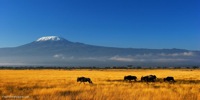Difference between revisions of "Plains"
(Created page with 'File:lighterstill.jpgright|frame '''Plains''' refer to the relatively smooth sections of the continental surfaces, occ...') |
m (Text replacement - "http://" to "https://") |
||
| Line 3: | Line 3: | ||
'''Plains''' refer to the [[relatively]] smooth sections of the [[continental]] [[surfaces]], occupied largely by [[gentle]] rather than steep slopes and exhibiting only small local [[differences]] in elevation. Because of their smoothness, plains [[lands]], if other conditions are favorable, are especially amenable to many [[human]] [[activities]]. Thus it is not surprising that the [[majority]] of the world's principal [[agricultural]] regions, close-meshed [[transportation]] networks, and [[concentrations]] of [[population]] are found on plains. Large parts of the [[Earth]]'s plains, however, are hindered for [[human]] use by [[Aridity|dryness]], shortness of frost-free [[season]], infertile [[soils]], or poor drainage. Because of the [[absence]] of major differences in elevation or [[exposure]] or of obstacles to the [[free]] movement of [[air]] masses, extensive plains usually exhibit broad [[uniformity]] or [[gradual]] [[transition]] of [[climatic]] characteristics. | '''Plains''' refer to the [[relatively]] smooth sections of the [[continental]] [[surfaces]], occupied largely by [[gentle]] rather than steep slopes and exhibiting only small local [[differences]] in elevation. Because of their smoothness, plains [[lands]], if other conditions are favorable, are especially amenable to many [[human]] [[activities]]. Thus it is not surprising that the [[majority]] of the world's principal [[agricultural]] regions, close-meshed [[transportation]] networks, and [[concentrations]] of [[population]] are found on plains. Large parts of the [[Earth]]'s plains, however, are hindered for [[human]] use by [[Aridity|dryness]], shortness of frost-free [[season]], infertile [[soils]], or poor drainage. Because of the [[absence]] of major differences in elevation or [[exposure]] or of obstacles to the [[free]] movement of [[air]] masses, extensive plains usually exhibit broad [[uniformity]] or [[gradual]] [[transition]] of [[climatic]] characteristics. | ||
| − | Somewhat more than one-third of the [[Earth]]'s [[land]] area is occupied by plains. With the exception of [[ice]]-sheathed [ | + | Somewhat more than one-third of the [[Earth]]'s [[land]] area is occupied by plains. With the exception of [[ice]]-sheathed [https://en.wikipedia.org/wiki/Antarctica Antarctica], each continent contains at least one major expanse of smooth [[land]] in addition to numerous smaller areas. The largest plains of [https://en.wikipedia.org/wiki/North_America North America], [https://en.wikipedia.org/wiki/South_America South America], and [https://en.wikipedia.org/wiki/Eurasia Eurasia] lie in the [[continental]] interiors, with broad extensions reaching to the Atlantic (and Arctic) Coast. The most extensive plains of [https://en.wikipedia.org/wiki/Africa Africa] occupy much of the [https://en.wikipedia.org/wiki/Sahara Sahara] and reach south into the [https://en.wikipedia.org/wiki/Congo Congo] and [https://en.wikipedia.org/wiki/Kalahari Kalahari] basins. Much of [https://en.wikipedia.org/wiki/Australia Australia] is smooth, with only the eastern margin lacking extensive plains. |
| − | [[Surfaces]] that approach true flatness, while not rare, [[constitute]] a minor portion of the world's plains. Most commonly they occur along low-lying coastal margins, the lower sections of major [[river]] systems, or the floors of inland basins. Nearly all are the products of extensive deposition by [[streams]] or in lakes or shallow [[seas]]. The [[majority]] of plains, however, are distinctly irregular in [[surface]] form, as a result of valley-cutting by [[streams]] or of irregular [[erosion]] and deposition by continental [[glaciers]].[ | + | [[Surfaces]] that approach true flatness, while not rare, [[constitute]] a minor portion of the world's plains. Most commonly they occur along low-lying coastal margins, the lower sections of major [[river]] systems, or the floors of inland basins. Nearly all are the products of extensive deposition by [[streams]] or in lakes or shallow [[seas]]. The [[majority]] of plains, however, are distinctly irregular in [[surface]] form, as a result of valley-cutting by [[streams]] or of irregular [[erosion]] and deposition by continental [[glaciers]].[https://www.answers.com/main/ntquery?s=plains&gwp=13] |
[[Category: Geography]] | [[Category: Geography]] | ||
Latest revision as of 02:37, 13 December 2020
Plains refer to the relatively smooth sections of the continental surfaces, occupied largely by gentle rather than steep slopes and exhibiting only small local differences in elevation. Because of their smoothness, plains lands, if other conditions are favorable, are especially amenable to many human activities. Thus it is not surprising that the majority of the world's principal agricultural regions, close-meshed transportation networks, and concentrations of population are found on plains. Large parts of the Earth's plains, however, are hindered for human use by dryness, shortness of frost-free season, infertile soils, or poor drainage. Because of the absence of major differences in elevation or exposure or of obstacles to the free movement of air masses, extensive plains usually exhibit broad uniformity or gradual transition of climatic characteristics.
Somewhat more than one-third of the Earth's land area is occupied by plains. With the exception of ice-sheathed Antarctica, each continent contains at least one major expanse of smooth land in addition to numerous smaller areas. The largest plains of North America, South America, and Eurasia lie in the continental interiors, with broad extensions reaching to the Atlantic (and Arctic) Coast. The most extensive plains of Africa occupy much of the Sahara and reach south into the Congo and Kalahari basins. Much of Australia is smooth, with only the eastern margin lacking extensive plains.
Surfaces that approach true flatness, while not rare, constitute a minor portion of the world's plains. Most commonly they occur along low-lying coastal margins, the lower sections of major river systems, or the floors of inland basins. Nearly all are the products of extensive deposition by streams or in lakes or shallow seas. The majority of plains, however, are distinctly irregular in surface form, as a result of valley-cutting by streams or of irregular erosion and deposition by continental glaciers.[1]
